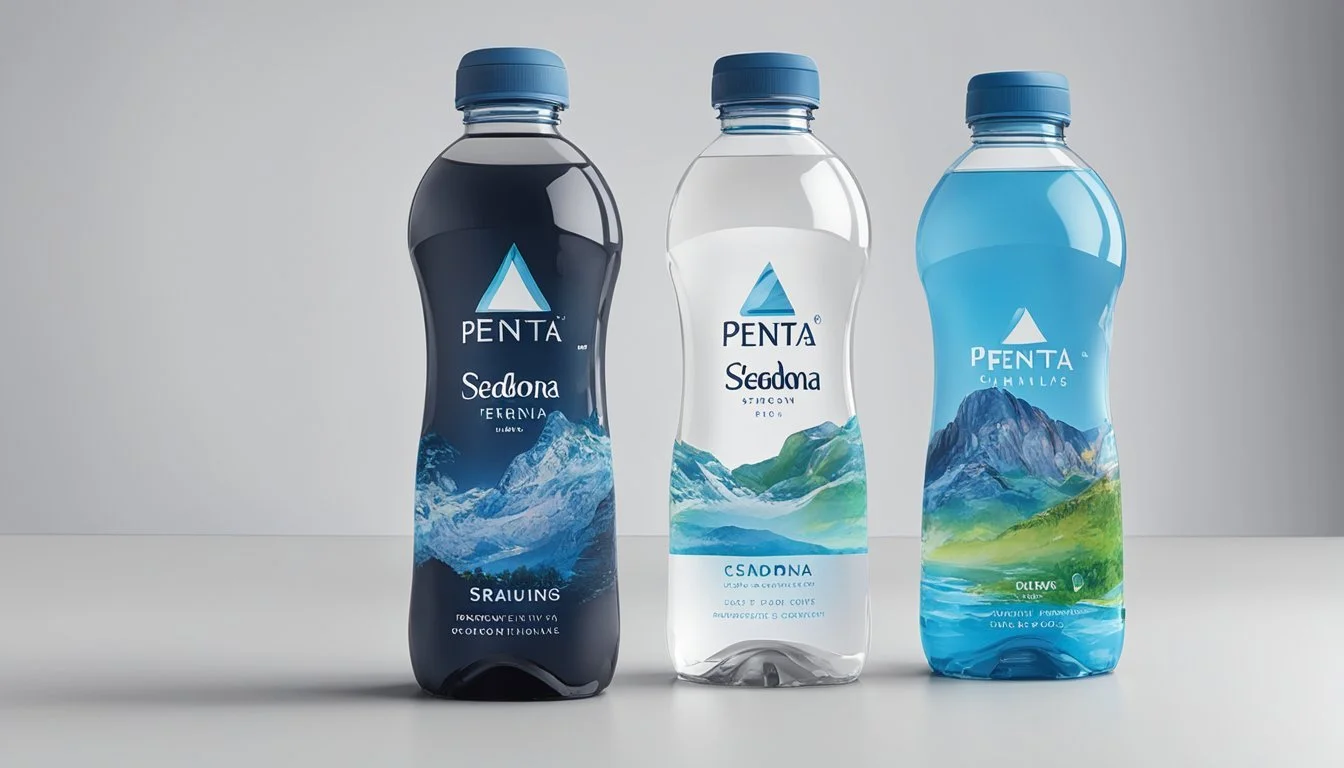Penta vs. Purely Sedona
A Comparison of Bottled Water Quality
Choosing the right bottled water can be a daunting task, especially when faced with options like Penta and Purely Sedona. Penta, known for its ultra-purified and oxygen-infused water, promises a clean and crisp taste. On the other hand, Purely Sedona boasts its natural artesian spring water sourced from the scenic Oak Creek Canyon in Sedona, Arizona, offering a refreshingly balanced mineral composition.
Consumers looking for a pure and unadulterated water experience may lean towards Penta for its advanced purification process that removes impurities and adds extra oxygen. Purely Sedona, with its commitment to natural sourcing and minimal processing, appeals to those who appreciate naturally sourced water with its unique mineral profile.
For those who prioritize purity and minimal additives, Penta stands out as the better choice, whereas individuals who prefer water with natural minerals may find Purely Sedona more appealing. This article will explore the qualities of both waters, helping you decide which one aligns with your preferences.
The Bottled Water Industry
The bottled water industry has seen substantial growth over recent years, driven by consumer preferences and marketing dynamics. This industry's evolution is influenced by various factors, including market trends and the criteria consumers use to select brands.
Market Dynamics
The bottled water market is a multibillion-dollar industry, with global sales expanding rapidly. Between 2010 and 2020, sales from 109 countries grew by 73%. This growth positions bottled water as one of the fastest-growing segments in the beverage market.
Key players such as Nestlé Waters and premium brands like Acqua Panna significantly shape the market. High-end collaborations and strategic marketing bolster their elite status. Regional brands like Purely Sedona focus on purity and local heritage to differentiate themselves.
Consumers' Choice Factors
Several factors influence consumer decisions in choosing bottled water brands. Quality and taste are primary considerations. Consumers often seek water that is pure and free from artificial additives.
Brand reputation and marketing also play crucial roles. Collaborations with fine dining establishments can enhance a brand's prestige. Health concerns, such as sodium content or the presence of preservatives, may deter consumers from certain brands.
Overall, choices are governed by a mix of sensory experience, health considerations, and brand perception.
Assessing Water Quality
This section provides a detailed look at the pH levels, mineral content, and safety standards of Penta and Purely Sedona bottled water, allowing readers to make an informed choice.
Importance of pH Levels
The pH level of water indicates its acidity or alkalinity, which can affect taste and potential health benefits. Penta water boasts a slightly acidic pH of around 5-7, promoting easy absorption and refreshing flavor. In contrast, Purely Sedona water has a more neutral pH, typically ranging from 7-8, aligning with the natural balance found in spring water.
Clearing up myths around pH, the ideal drinking water should typically fall between 6.5 and 8.5, according to EPA standards. Both brands maintain pH levels within this range, ensuring consumer safety and satisfaction.
Mineral Content and Health Benefits
Minerals in bottled water add to its health benefits and influence taste. Penta goes through a complex purification process, resulting in ultra-pure water with minimal mineral content, focusing on hydration over added health benefits.
Purely Sedona, sourced from natural springs, retains essential minerals like calcium and magnesium. These minerals not only enhance the taste but also contribute to daily nutritional needs.
Consumers looking for mineral-rich water might prefer Purely Sedona for its balanced composition, while those seeking pure hydration might opt for Penta.
Safety Standards and Regulations
Both Penta and Purely Sedona adhere to rigorous safety standards set by authorities like the EPA and FDA. These standards ensure the absence of contaminants and the preservation of water quality.
Penta undergoes a 13-step purification process, removing impurities to provide ultra-pure water. This meticulous approach meets and often exceeds safety regulations. Purely Sedona’s natural filtration through sedimentary rocks offers a pristine source of spring water, regularly tested to comply with EPA standards for bottled water.
Strict adherence to safety protocols ensures consumers enjoy pure, safe, and quality water from both brands.
Source and Filtration Processes
Penta and Purely Sedona offer distinct advantages in their source and filtration processes. Penta relies heavily on advanced purification methods, while Purely Sedona focuses on the natural quality of its spring water.
Natural Spring Water vs. Purified Water
Purely Sedona sources its water from a natural spring, emphasizing its natural mineral composition and alkalinity. The water's pH of 8 makes it slightly alkaline, appealing to health-conscious consumers. Natural spring water often contains electrolytes and essential minerals, which can benefit hydration and overall health.
Penta, on the other hand, uses purified water that undergoes multiple stages of filtration. This process eliminates contaminants, ensuring the water is free from impurities and safe to drink. The primary draw is its purity, although it lacks the natural minerals found in spring water.
Advanced Filtration Techniques
Penta employs 11-step purification techniques, including reverse osmosis, microfiltration, and ultraviolet light exposure. Reverse osmosis is particularly effective in removing dissolved salts and inorganic molecules. Microfiltration extracts tiny particles, and UV light kills bacteria and viruses, resulting in exceptionally pure water.
Purely Sedona, while source-focused, also implements stringent filtration processes. After collecting from the spring, the water undergoes multiple filtration stages to remove any potential contaminants. Nevertheless, the filtration is less intensive than Penta’s, aiming to maintain the water's natural mineral and alkaline properties.
Environmental Considerations
Purely Sedona emphasizes eco-friendly practices throughout its sourcing and packaging. The company uses recyclable materials to minimize its environmental impact. In addition to employing sustainable bottling methods, they focus on conserving local resources and reducing waste.
Penta, while less focused on packaging sustainability, invests in minimizing the environmental footprint of its water purification processes. Advanced filtration techniques, although energy-intensive, are managed to balance method efficacy with environmental responsibility.
Both brands show commitment to environmental standards, but Purely Sedona takes a more comprehensive approach by integrating eco-friendly practices into its entire supply chain.
Comparative Analysis
Penta and Purely Sedona are notable for their unique purification processes and sources. Each offers distinct advantages in terms of taste, hydration, and overall water quality.
Penta's Hydro-7 Filtration
Penta stands out with its Hydro-7 Filtration. This patented process includes 13 steps aimed at delivering ultra-pure water. The Hydro-7 system effectively removes impurities, ensuring a high level of cleanliness.
Penta water typically has a neutral pH level, contributing to its crisp taste. It also avoids the use of artificial additives, making it appealing to those looking for purity. Electrolytes are minimal, focusing purely on hydration without added minerals. This makes Penta suitable for those requiring pure hydration.
Purely Sedona's Natural Spring Source
Purely Sedona sources its water from natural springs, specifically from the Sedona area, known for its high-quality water. This natural spring source is rich in minerals and electrolytes, which can enhance hydration.
The water is naturally alkaline, offering potential health benefits by balancing body's pH. The mineral content gives Purely Sedona a unique taste profile, appealing to those preferring water with natural elements.
Taste Profile and Preference
Taste is subjective but plays a crucial role in the choice between Penta and Purely Sedona. Penta offers a clean, neutral taste, free from aftertaste, which many find refreshing. It's ideal for individuals who prefer minimalistic, pure water without added minerals.
In contrast, Purely Sedona has a distinct mineral taste due to its natural spring origin. This taste can be more appealing to those who enjoy the natural flavors of mineral water.
While both brands provide excellent hydration, choosing between them often comes down to personal preference for taste and desired water quality attributes.
Health Implications
When evaluating Penta and Purely Sedona bottled waters, it is essential to consider their effects on hydration, athletic performance, and daily mineral intake. These factors play a crucial role in determining which water is better for your health.
Hydration and Athletic Performance
Proper hydration is vital for everyone, especially athletes. Penta water undergoes a thorough purification process, resulting in ultra-pure water free of impurities, which can quickly hydrate the body. However, it lacks the natural minerals found in other waters.
Purely Sedona features natural minerals like calcium, magnesium, and potassium, which are beneficial for athletic performance. These minerals support muscle function and reduce cramping, making it a preferable option for those engaged in rigorous physical activities.
Athletes choosing between Penta and Purely Sedona should consider their needs: Penta’s purity might appeal to those needing immediate hydration, while Purely Sedona’s mineral content may benefit those looking for added health support during workouts.
Contribution to Daily Mineral Intake
Minerals are essential for maintaining good health. Purely Sedona contains naturally occurring minerals from its spring source, providing calcium and magnesium, which are crucial for bone health and muscle function. Additionally, potassium in Purely Sedona supports cardiovascular health and proper muscle contractions.
In contrast, Penta water, being highly purified, lacks these natural minerals. While it may ensure hydration, it does not contribute to the daily intake of essential minerals.
Consumers who need to boost their intake of minerals like calcium, magnesium, or potassium might find Purely Sedona more advantageous compared to Penta, which is better for those preferring ultra-pure water without extra mineral content.
Brand Propositions
This section examines the marketing strategies and customer trust levels that underpin Penta and Purely Sedona, two prominent names in the bottled water industry.
Marketing and Brand Image
Penta positions itself as a premium, ultra-purified water brand, focusing on purity and quality. Their marketing highlights the absence of electrolytes and trace elements, appealing to health-conscious consumers who prioritize water purity.
Purely Sedona, on the other hand, emphasizes its natural origins and artisanal approach. The brand markets its water as coming from pristine, protected sources, aiming to evoke a sense of authenticity and natural purity. This aligns with the current trend of consumers seeking products that are minimally processed.
Essentia and Core also emphasize specific health benefits and unique selling points such as pH-balanced water or added electrolytes. These aspects shape their brand images and target different consumer preferences.
Customer Trust and Loyalty
Penta enjoys a high level of trust due to its transparent purification process and commitment to maximum purity. Customers who are particular about contamination and water quality tend to remain loyal to Penta. Reviews often highlight the consistent taste and reliability of the product.
Purely Sedona builds trust through its commitment to sourcing from protected, high-quality locations. Customers who value eco-friendliness and natural water sources often prefer Purely Sedona, contributing to brand loyalty.
Brands like Coca-Cola utilize their extensive distribution networks and brand recognition to foster customer trust. Although primarily known for its soft drinks, its bottled water brands benefit from the parent company's established reputation.
Both Penta and Purely Sedona rely on specific customer values to cultivate loyalty, whether it's through purity or natural sourcing, shaping their unique brand propositions in a competitive market.
Packaging and Sustainability
Penta and Purely Sedona differentiate themselves through their packaging choices and commitment to sustainability. Each brand has a distinct approach to reducing environmental impact and plastic waste.
Environmental Footprint of Bottled Water
Purely Sedona sources its water from Oak Creek Canyon in Arizona, emphasizing the pristine conditions of its protected spring. The brand opts for eco-friendly packaging, often using reusable glass bottles. Although this choice reduces plastic waste, it carries a higher environmental cost in terms of production and recycling energy.
Penta, on the other hand, uses BPA-free plastic bottles. While these bottles are lighter and potentially safer for consumers, they still contribute to the substantial problem of plastic waste. Moreover, the production and disposal of plastic bottles have significant environmental impacts, including contributing to landfill overflow and marine pollution.
Innovations in Eco-Friendly Packaging
Both brands incorporate innovations to improve their sustainability. Purely Sedona highlights its use of glass bottles, arguing that they offer a longer lifespan and better reusability compared to single-use plastics. These glass bottles, despite their heavier weight, can be sanitized and refilled multiple times.
Meanwhile, Penta focuses on improving its plastic bottles by making them BPA-free, which mitigates some health risks associated with plastic. Additionally, while the packaging isn't biodegradable, it is designed for easier recycling processes, aiming to minimize its footprint.
Boxed Water is also noteworthy in the context of sustainable packaging, although not directly part of Penta or Purely Sedona. It uses paper-based cartons which are more environmentally friendly compared to plastic. This development reflects a broader industry trend towards innovative and sustainable packaging solutions.
Water in Fine Dining
In the realm of fine dining, the choice of bottled water can reflect the establishment's commitment to quality and the overall dining experience. The purity and smooth taste of the water play crucial roles in complementing gourmet meals.
Role of Water Quality in Gastronomy
Water Quality: In high-end restaurants, water purity ensures there are no unpleasant tastes or contaminants that could interfere with delicate flavors. Brands like Acqua Panna are often chosen for their clean and smooth profile, enhancing the dining experience.
Pairing with Cuisine: Smooth-tasting water pairs well with elaborate dishes, without overpowering the subtle flavors. Fine dining establishments often select bottled waters that maintain consistent quality, ensuring that each sip complements the taste of the food.
Presentation: The choice of bottled water also mirrors the restaurant’s sophistication. Serving recognized brands signals attention to detail and commitment to excellence. This enhances the overall ambiance and customer perception.
Final Considerations
In comparing Penta and Purely Sedona, it's crucial to examine how each brand meets consumer expectations and predict future trends in the bottled water industry. These aspects will provide a comprehensive perspective on choosing between these two brands.
Aligning Brand Values with Consumer Expectations
Penta focuses on purity and hydration, utilizing a proprietary 13-step purification process. They market their water as ultra-pure, free from additives, and aimed at health-conscious consumers. This appeals to those prioritizing purity and advanced filtration.
Purely Sedona, on the other hand, emphasizes local heritage and natural purity. Bottled in the Sedona region, the brand highlights its connection to nature and purity. This appeals to consumers who value local sourcing and natural origins in their bottled water choices.
Both brands meet distinct consumer expectations: Penta with technologically advanced purification and Purely Sedona with its emphasis on natural purity and local heritage. Understanding these values helps consumers align their preferences with the brand that best meets their hydration needs.
Future Trends in Bottled Water
The bottled water industry is shifting towards sustainability and transparency. Consumers demand information about water sources, purification processes, and environmental impacts. Brands are expected to provide detailed reports and maintain eco-friendly practices.
Penta could benefit from focusing on eco-friendly packaging and transparent sourcing to meet these evolving expectations. Enhancing sustainability efforts could attract environmentally conscious consumers.
Purely Sedona's local harvesting and natural branding position it well for future trends. Emphasizing sustainable practices and minimizing carbon footprints will likely resonate with future consumer demands. Investing in eco-friendly initiatives and transparent reporting can further cement its market position.
Understanding these trends helps consumers make informed decisions and encourages brands to adapt to future market dynamics.
More About Penta
Mountain Valley Spring Water vs Penta: Which Bottled Water is Better?
Penta vs Richard's Rainwater: Which Bottled Water is Better?
Penta vs Whole Foods Italian Still Mineral water: Which Bottled Water is Better?
More About Purely Sedona
Aqua Carpatica vs Purely Sedona: Which Bottled Water is Better?
Boxed Water vs Purely Sedona: Which Bottled Water is Better?
Castle Rock vs Purely Sedona: Which Bottled Water is Better?
Core Hydration vs Purely Sedona: Which Bottled Water is Better?
Hawaii Volcanic vs Purely Sedona: Which Bottled Water is Better?
Hawaiian Springs vs Purely Sedona: Which Bottled Water is Better?
Ice Mountain vs Purely Sedona: Which Bottled Water is Better?
Icelandic Glacial vs Purely Sedona: Which Bottled Water is Better?
Mountain Valley Spring Water vs Purely Sedona: Which Bottled Water is Better?
Nestle Pure Life vs Purely Sedona: Which Bottled Water is Better?
Poland Spring vs Purely Sedona: Which Bottled Water is Better?
Purely Sedona vs Cascade Mountain: Which Bottled Water is Better?
Purely Sedona vs Crystal Geyser: Which Bottled Water is Better?
Purely Sedona vs Crystal Lake: Which Bottled Water is Better?
Purely Sedona vs Essence pH10: Which Bottled Water is Better?
Purely Sedona vs Kirkland Signature: Which Bottled Water is Better?
Purely Sedona vs Liquid Death: Which Bottled Water is Better?
Purely Sedona vs Proud Source: Which Bottled Water is Better?
Purely Sedona vs Richard's Rainwater: Which Bottled Water is Better?
Purely Sedona vs Simple Truth: Which Bottled Water is Better?
Purely Sedona vs Talking Rain AQA: Which Bottled Water is Better?
Purely Sedona vs Weird Water: Which Bottled Water is Better?
Purely Sedona vs Whole Foods 365: Which Bottled Water is Better?
Purely Sedona vs Whole Foods Italian Still Mineral water: Which Bottled Water is Better?
San Pellegrino vs Purely Sedona: Which Bottled Water is Better?
Solan de Cabras vs Purely Sedona: Which Bottled Water is Better?
Zephyrhills vs Purely Sedona: Which Bottled Water is Better?








